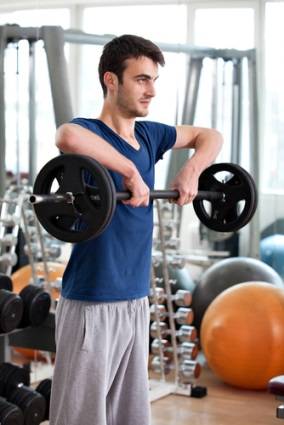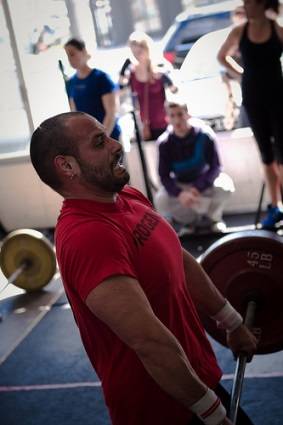I don’t know how many times I have had people ask me why the weightlifters they see in the Olympics don’t have very impressive arms. “Nowhere near what that Arnold Whatshisname has!” To the man in the street it seems “lifting” something means you gotta use your arms. Especially when you lift something heavy from the floor. What could be simpler?
As with my discussion last week about the press-jerk confusion there is also much of the same with the pull-type lifts, especially with those who are self-coached or poorly coached. These lifts have changed a lot in the last half-century or so. However, it is hard to see this change when watching lifts at their normal speed. The lifter reefs on the bar and then it is up, all within a second or so. It is because of this speed that misconceptions can develop. Some of this is due to human nature, but some also can be blamed on the rules used in decades gone by. Let’s look at those old rules.
In the old days, pre-1968, all snatches and cleans had to be pulled all the way up without touching the body at any point, although some referees ignored touches below the knee. What this meant technique-wise was that the Olympic lifts had to be pulled up with hip and arm strength. George Kirkley described the pre-1968 pull very succinctly in the Manual of Weight Training:
Basically there are three parts to the pull:
a) The lift
b) The Swing
c) Arm and Shoulder Pull
Arms had little relevance in the first pull (“a” above). They were only hooks while the legs were used to get the bar moving off the floor. For that matter arms still don’t have much relevance today. Once the bar got to the knees the legs were of little further use.
After passing the knees the second pull belonged to the upper body. At that point the lifter would gradually open up his hips (“b” above) while simultaneously starting the pull with his arms and shoulders (“c” above). (I use his for a reason – remember there was no her then.) Because of the rule against body touching by the bar, the weight was always too far away from the body for effective leverage. This is why many lifters from the 1950s had poor leg strength, but it was also why many had bigger biceps and great back strength.
At the top of the lift the lifter would literally drop down into the squat, trying his best to beat the bar down to the bottom. There was no thought of it becoming a third pull and settling into it with more precision. Bar crashings onto the lifter were common when the amortization was miscalculated.
 As might be expected, lifters trained their power cleans and power snatches the same way – lots of arms and backs. Heavy pull workouts were literally a pain-in-the-glutes as these muscles had to put a lot of force into the long, first-class lever that a back-pulled lift actually is. Not only that, the erectors had a lot of third-class work to do as well. And all lifters had to be taught how to leave their arms out of the separation stage.
As might be expected, lifters trained their power cleans and power snatches the same way – lots of arms and backs. Heavy pull workouts were literally a pain-in-the-glutes as these muscles had to put a lot of force into the long, first-class lever that a back-pulled lift actually is. Not only that, the erectors had a lot of third-class work to do as well. And all lifters had to be taught how to leave their arms out of the separation stage.
In 1968 the rules were changed to allow a thigh-brush when it was realized that pulling closer was more efficient and touching the body gave no advantage. In 1972 the rules allowed full contact. Of course, this resulted in more misconceptions. Many lifters saw the resultant thigh banging as “the secret” to bigger lifts. Violent contact was cultivated. It took years to get this habit eliminated in lifters. The rules may have been changed but the old errors have not been eliminated. This is especially true now that other weight disciplines are exerting their influences, sometimes good, sometimes not so good.
To illustrate this, I was in my local gym one day when I saw a young man doing a very strange lift. I asked him what it was. He answered that it was a power clean. I asked him who taught him the “lift.” “My high school football coach. He used to be a powerlifter,” was his reply, assuming this reference implied that he was trained by some sort of expert. (No slam on the power boys, just read on.) What was he doing? I’ll try to describe it. When he was ready he strode up to the bar and got himself into a wide, sumo-style deadlift start position. If he could have placed his feet outside the plates I’m sure he would have tried. When he was ready he simply rose out of the sumo position and then did an energetic upright row and then a reverse curl to rack the bar. It was simply unbelievable.
There is a place for the sumo start but it is not in power cleaning. (Whether there is a place for the upright row, that’s another question.) You do see a lot of training advice offered by writers who allow the substitution of the upright row if the lifter just can’t (read: don’t want to) do the power clean. This advice often stems from the bodybuilding people who put much more emphasis on rowing movements and much less on cleaning. They do look similar to the layman or novice trainee, but they are two different things. Power cleans are a triple joint extension exercise. Upright rows are an arm and trap contraction exercise. And, even then, it is the latter only if your shoulder flexibility allows it. Those with tight shoulders will usually have rotator problems with the upright row.
 So, we now know that pulls are not an arm exercise when the bar is above the knees. What some do not seem to realize is that they are also not an arm exercise when the bar is below the knees. How many people do you see waltz up to their deadlifts or clean, get into position, set their grip, maybe wrap their straps, and then start their pull by trying to yank the bar off the floor? Oddly enough, these are the same people who know that they cannot curl 100lbs, but somehow think they will jerk-pull 300lbs off the ground. (At least my man two paragraphs back separated slowly. Fortunately his powerlifting training helped him there.)
So, we now know that pulls are not an arm exercise when the bar is above the knees. What some do not seem to realize is that they are also not an arm exercise when the bar is below the knees. How many people do you see waltz up to their deadlifts or clean, get into position, set their grip, maybe wrap their straps, and then start their pull by trying to yank the bar off the floor? Oddly enough, these are the same people who know that they cannot curl 100lbs, but somehow think they will jerk-pull 300lbs off the ground. (At least my man two paragraphs back separated slowly. Fortunately his powerlifting training helped him there.)
The lesson here and from last week is that in order to program your training most effectively you have to know what muscles are being worked and how that work will help your sport. You need to know this for each exercise you are contemplating. Cleans look like an arm exercise but are not. Upright rows look like a clean but are not. Jerks look similar to presses but are not.
Take a look at what is really happening, not what appears to be happening. Are your arms pulling you under the bar or are they rowing a weight upwards? The answer here is important regardless of what you may be calling the exercise you are doing.
References:
1. Kirkley, George W., & John Goodbody, “The Manual of Weight Training,” Stanley Paul & Co., London, 1967, UK, p. 129
Photos 1 & 3 courtesy ofCrossFit LA.
Photo 2 courtesy ofShutterstock.






